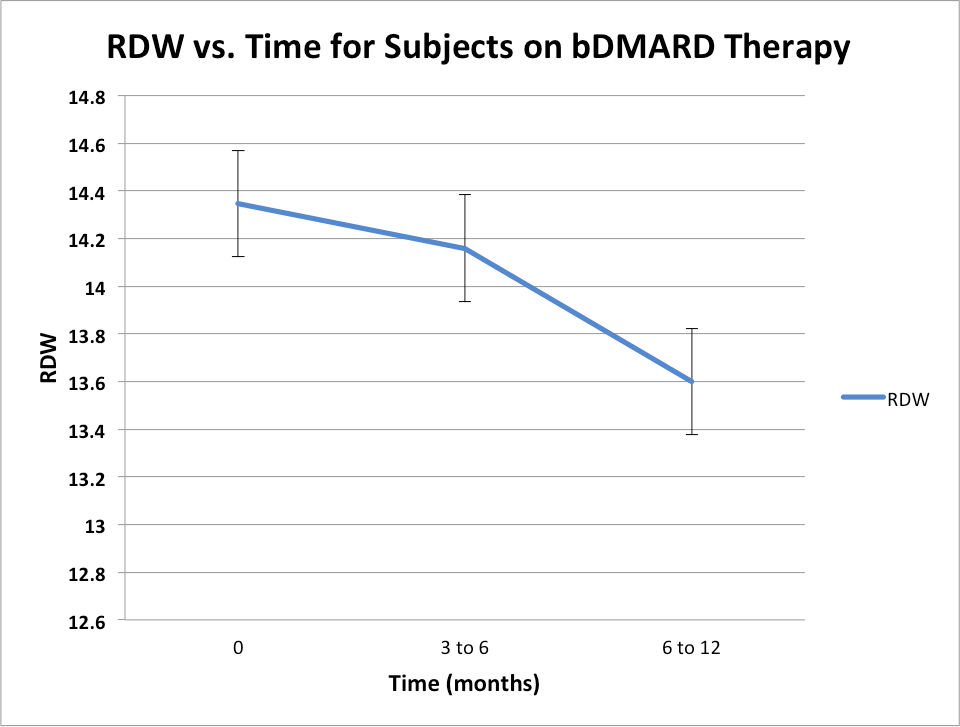Session Information
Session Type: Poster Session (Tuesday)
Session Time: 9:00AM-11:00AM
Background/Purpose: Red blood cell distribution width (RDW) is a parameter that measures variation in red blood cell size and volume. It is elevated when there is variation in red cell size (anisocytosis). RDW has been found to be a predictor of cardiovascular disease (CVD), but is not commonly incorporated in current risk evaluation instruments. Research has linked an elevated RDW to disease activity in psoriasis, but limited data is available on the relationship between these parameters and psoriatic arthritis.
Methods: We performed a retrospective chart review study examining the relationship between RDW, MPV, hemoglobin, absolute lymphocyte count (ALC), and atherosclerotic cardiovascular disease (ASCVD) 10 year risk score (incorporating age, hypertension status, diabetes mellitus (DM) status, lipid profile, and smoking status) in a cohort of patients with psoriatic arthritis, taking into account their HLA-B27 status, race, and treatment history.
Results: RDW was positively correlated with ASCVD score, and RDW was found to decrease over 12 months for all patients started on bDMARD therapy. As expected, we found positive correlations between ASCVD score, hemoglobin A1c, and age, and negative correlations between ASCVD score, hemoglobin, and albumin. Patients started on NSAID therapy had a statistically significant increase in RDW between time 0 and 6 months (p = 0.03), but this was not maintained at twelve months. Patients on csDMARD therapy did not experience a statistically significant change in RDW at 6 or 12 months, while patients on bDMARD and bDMARD + csDMARD therapy experienced a statistically significant decline in RDW from 0 to 6 months (p = 0.046) and from 0 to 12 months (p = 0.040). When patients on bDMARD therapy were analyzed alone, a trend towards a decline in RDW from 0 to 12 months was also observed (p = 0.11).
Conclusion: This data shows that not only is there is a positive correlation between RDW and traditional cardiovascular risk factors, as represented by ASCVD score, in patients with psoriatic arthritis, but also that bDMARD therapy appears to be associated with decreasing RDW in these patients over time, the latter consistent with RDW in part reflecting disease activity. Whether RDW adds to cardiovascular risk assessment beyond traditional cardiovascular risk factor analysis is yet to be determined. Data here suggest it may be a viable candidate since it appears to reflect both disease activity and traditional risk factors. More investigation related to bDMARD therapy and other non-conventional parameters of disease activity in psoriatic arthritis as they relate to CVD is warranted. This could have powerful clinical implications, as having other approaches of monitoring disease activity (aside from ESR and CRP) would be beneficial for patients.
To cite this abstract in AMA style:
Gupta A, Damjanovska S, Zidar D, Anthony D, Mattar M. Red Cell Distribution Width Positively Correlates with Atherosclerotic Cardiovascular Disease Risk Score in Psoriatic Arthritis and Decreases with BDMARD Therapy [abstract]. Arthritis Rheumatol. 2019; 71 (suppl 10). https://acrabstracts.org/abstract/red-cell-distribution-width-positively-correlates-with-atherosclerotic-cardiovascular-disease-risk-score-in-psoriatic-arthritis-and-decreases-with-bdmard-therapy/. Accessed .« Back to 2019 ACR/ARP Annual Meeting
ACR Meeting Abstracts - https://acrabstracts.org/abstract/red-cell-distribution-width-positively-correlates-with-atherosclerotic-cardiovascular-disease-risk-score-in-psoriatic-arthritis-and-decreases-with-bdmard-therapy/



